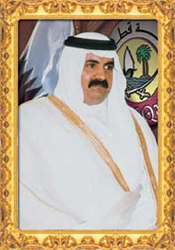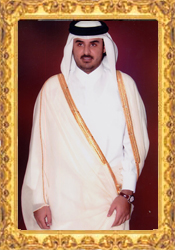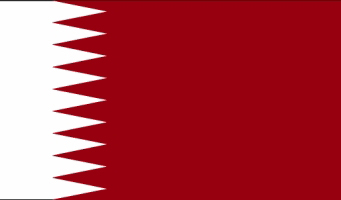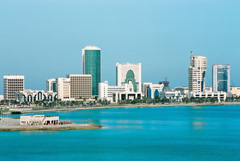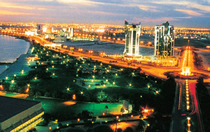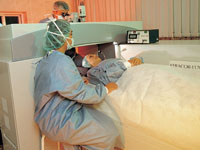|
|
|
||||||||
|
|
|||||||||
|
|
|||||||||
|
Overview |
|||||||||
|
Qatar is one of the smaller Arab Gulf states in terms of population and geographical area. It is situated midway along the western coast of the Arabian Gulf between latitudes 24.27° - 26.10° North and longitude 50.45° - 51.40° East. The country’s area is approximately 11,437 square kilometers and covers a low-lying limestone peninsula projecting northwards about 160 kilometres into the Gulf. The coastline is 550 kilometers long and bounds the country to the west, north, and east. The landscape of Qatar is generally flat arid desert terrain. The desert areas are predominantly low lying with the exception of scattered hill formations in the north west and rolling sand dunes in the south east areas.
|
|||||||||
|
|
|||||||||
|
Qatar gained independence on September 3rd 1971. On the 27Th of June 1995 His Highness Sheikh Hamad Bin Khalifa Al-Thani assumed the rule of the State of Qatar supported by the ruling family and the Qatari people. |
|||||||||
|
The national flag is maroon colour with a broad vertical white stripe at the pole, the two colours being separated with a nine-point serrated line.
|
|||||||||
|
Climate |
|||||||||
|
The climate is characterised by a mild winter and a hot summer. Rainfall in the winter is slight, averaging some 80 millimeters a year. emperatures range from 7 degrees centigrade in January to around 45 degrees at the height of summer. The weather is generally pleasant during the period from October until May. |
|||||||||
|
Population |
|||||||||
|
In March 2004, The Planning Council announced the preliminary phase results of the new population census. According to the 2004 census, Qatar’s population reached 742,883 increasing by 42.3% from the 1997 census of 522,023. As per the 2004 census, 45.6% of the total population resided in Doha, while 36.7% of the population resided in Al-Rayyan. The 2004 census shows an average annual increase of 6.0% during the period 1997-2004, compared to the annual average increase of 3.7% during 1986-1997. The rapid increase in population over the last few years is attributed to the strong performance of the economy, which has resulted in a large number of projects coming online, thereby leading to the influx of professionals, service and contracting sector staff and others. |
|||||||||
|
Capital City |
|||||||||
|
Doha City
|
|||||||||
|
Official Language |
|||||||||
|
Arabic is the official language in Qatar, and English is widely spoken. |
|||||||||
|
Religion |
|||||||||
|
Islam is the official religion of the country, and the Shariah (Islamic Law) is the principal source of legislation in the country. |
|||||||||
|
Major Towns |
|||||||||
|
Doha, Al Wakrah, Al Khor, Dukhan, Al Shamal, Mesaieed, Ras Lafan and others. |
|||||||||
|
Currency: |
|||||||||
|
The official currency is the Qatari Riyal (QR), which is divided into 100 dirhams. The Exchange parity has been set at the fixed rate of US $ = 3.65QR's. |
|||||||||
|
PUBLIC HOLIDAYS: |
|||||||||
|
Independence
Day: 3rd September. |
|||||||||
|
WORK HOURS |
|||||||||
|
Government
offices: 7 am to 2 pm. |
|||||||||
|
LOCAL TIME |
|||||||||
|
3 hours + Greenwich Mean Time. |
|||||||||
|
ELECTRICAL CURRENT |
|||||||||
|
240 Volts + 6% with frequency 50 hertz. |
|||||||||
|
Medical Services |
|||||||||
|
Medical and dental treatment is available at a nominal charge to all residents and visitors, through the public Hamad General Hospital, Rumailah Hospital, and the many health centres in Qatar. Qatar’s first major private hospital, the 250-bed Al-Ahli hospital was opened in 2004. Also currently present are private medical facilities like the American Hospital and Doha Clinic Hospital. In order to receive medical treatment from clinics and hospitals, it is necessary for foreign residents to obtain health cards. On payment of a nominal fee (QR 100 per person), these are issued by the nearest clinic on production of relevant residence permits. Health cards must be shown on all clinic and hospital visits. |
|||||||||
|
Transportation & Communication |
|||||||||
|
Qatar has made remarkable progress in the fields of telecommunications,
postal services, roads as well as sea ports and airports. To strengthen
this sector and make it more independent and effective, the Ministry
of Communications and Transport was dissolved and three Emiri decrees
were issued to set up the Civil Aviation Authority, Customs and
Ports Authority and Postal Services Authority.
|
|||||||||
|
|
|||||||||
|
|||||||||

